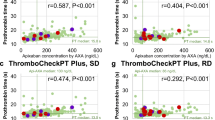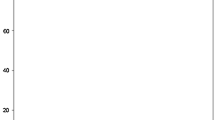Abstract
Background
There is a paucity of data on apixaban levels among octogenarians with non-valvular atrial fibrillation (NVAF). We aimed to compare apixaban levels between octogenarians (with and without dose reduction) and younger patients, to assess the frequency of high and above-range drug levels.
Methods
A cross-sectional, prospective study of 80 patients treated with apixaban for NVAF was conducted. Apixaban levels were compared among octogenarians treated with 5 mg twice daily (bid), octogenarians with appropriately reduced dose (2.5 mg bid), octogenarians with inappropriately reduced dose and younger patients (age < 70 years). Trough and peak levels were measured by a chromogenic assay calibrated for apixaban and compared to predicted manufacturer levels.
Results
A significant proportion of the cohort had above-range trough [n = 11 (13.8%)] and peak [n = 16 (20%)] levels, especially octogenarians with the 5-mg bid dosage [n = 6 (30%) for trough and n = 8 (40%) for peak]. No significant differences were found in the trough or peak geometric mean (GM) levels among the groups, apart from the peak GM levels between the 5-mg octogenarian group and the other two 2.5-mg bid octogenarian groups (p = 0.0004). The frequency of apixaban peak levels within the upper quartile was significantly higher in the 5-mg octogenarian group compared to the other groups [n = 12 (60%) of measurements, p = 0.019), whereas trough levels were comparable between groups.
Conclusion
High and above-range peak apixaban steady-state levels are highly prevalent in octogenarians receiving the appropriate dosage of 5 mg bid for NVAF stroke prevention. Age above 80 strongly affects apixaban levels.
Trial Registration
ClinicalTrials.gov Identifier number NCT02623049.


Similar content being viewed by others
Abbreviations
- ACE-I:
-
Angiotensin-converting enzyme inhibitor
- AF:
-
Atrial fibrillation
- AFXa:
-
Anti-factor Xa activity
- ALT:
-
Alanine aminotransferase
- ANCOVA:
-
Analysis of covariance
- ANOVA:
-
Analysis of variance
- aPTT:
-
Activated partial thromboplastin time
- ARB:
-
Angiotensin receptor blocker
- AST:
-
Aspartate aminotransferase
- AUC:
-
Area under the curve
- BMI:
-
Body mass index
- bid:
-
Twice a day
- CHF:
-
Chronic heart failure
- CKD:
-
Chronic kidney disease
- CrCl:
-
Creatinine clearance
- CV%:
-
Coefficient of variation
- CYP3A4:
-
Cytochrome P450 3A4
- DOAC:
-
Direct oral anticoagulant
- FDA:
-
Food and Drug Administration
- GM:
-
Geometric mean
- INR:
-
International normalized ratio
- ISTH:
-
International Society on Thrombosis and Haemostasis
- NVAF:
-
Non-valvular atrial fibrillation
- OD/min:
-
Optical density generated per minute
- P-gp:
-
P-glycoprotein
- sCr:
-
Serum creatinine
- SD:
-
Standard deviation
- T max :
-
Time to reach maximum (peak) plasma concentration
- ULN:
-
Upper limit of normal
- Xa:
-
Factor Xa
References
Haim M, Hoshen M, Reges O, et al. Prospective national study of the prevalence, incidence, management and outcome of a large contemporary cohort of patients with incident non-valvular atrial fibrillation. J Am Heart Assoc. 2015;4(1):e001486.
Kirchhof P, Benussi S, Kotecha D, et al. 2016 ESC guidelines for the management of atrial fibrillation developed in collaboration with EACTS. Eur Heart J. 2016;37(38):2893–962.
Go AS, Hylek EM, Phillips KA, et al. Prevalence of diagnosed atrial fibrillation in adults: national implications for rhythm management and stroke prevention: the AnTicoagulation and Risk Factors in Atrial Fibrillation (ATRIA) Study. JAMA. 2001;285(18):2370–5.
Granger CB, Alexander JH, McMurray JJ, et al. ARISTOTLE Committees and Investigators. Apixaban versus warfarin in patients with atrial fibrillation. N Engl J Med. 2011;365(11):981–92.
Halvorsen S, Atar D, Yang H, et al. Efficacy and safety of apixaban compared with warfarin according to age for stroke prevention in atrial fibrillation: observations from the ARISTOTLE trial. Eur Heart J. 2014;35(28):1864–72.
Stöllberger C, Finsterer J. Concerns about the use of new oral anticoagulants for stroke prevention in elderly patients with atrial fibrillation. Drugs Aging. 2013;30(12):949–58.
Held C, Hylek EM, Alexander JH, et al. Clinical outcomes and management associated with major bleeding in patients with atrial fibrillation treated with apixaban or warfarin: insights from the ARISTOTLE trial. Eur Heart J. 2015;36(20):1264–72.
European Medicines Agency. Eliquis—summary of product characteristics. http://www.ema.europa.eu/docs/en_GB/document_library/EPAR_-_Product_Information/human/002148/WC500107728.pdf. Accessed 10 May 2018
Gosselin RC, Adcock DM, Bates SM, et al. International Council for Standardization in Haematology (ICSH) recommendations for laboratory measurement of direct oral anticoagulants. Thromb Haemost. 2018;118(3):437–50.
Steffel J, Verhamme P, Potpara TS, ESC Scientific Document Group, et al. The 2018 European Heart Rhythm Association Practical Guide on the use of non vitamin K antagonist oral anticoagulants in patients with atrial fibrillation. Eur Heart J. 2018;39(16):1330–93.
Cuker A, Siegal DM, Crowther MA, et al. Laboratory measurement of the anticoagulant activity of the non-vitamin K oral anticoagulants. J Am Coll Cardiol. 2014;64(11):1128–39.
Kitchen S, Gray E, Mackie I, BCSH Committee, et al. Measurement of non-coumarin anticoagulants and their effects on tests of haemostasis: guidance from the British Committee for Standards in Haematology. Br J Haematol. 2014;166(6):830–41.
Frost CE, Song Y, Shenker A, et al. Effects of age and sex on the single-dose pharmacokinetics and pharmacodynamics of apixaban. Clin Pharmacokinet. 2015;54(6):651–62.
Frost C, Nepal S, Wang J, et al. Safety, pharmacokinetics and pharmacodynamics of multiple oral doses of apixaban, a factor Xa inhibitor, in healthy subjects. Br J Clin Pharmacol. 2013;76(5):776–86.
Manikandan S. Measures of central tendency: the mean. J Pharmacol Pharmacother. 2011;2(2):140–2.
Testa S, Tripodi A, Legnani C, et al. START-Laboratory Register. Plasma levels of direct oral anticoagulants in real life patients with atrial fibrillation: results observed in four anticoagulation clinics. Thromb Res. 2016;137:178–83.
Alexander JH, Andersson U, Lopes RD, Apixaban for Reduction of Stroke and Other Thromboembolic Complications in Atrial Fibrillation (ARISTOTLE) Investigators, et al. Apixaban 5 mg twice daily and clinical outcomes in patients with atrial fibrillation and advanced age, low body weight, or high creatinine: a secondary analysis of a randomized clinical trial. JAMA Cardiol. 2016;1(6):673–81.
Sardar P, Chatterjee S, Chaudhari S, et al. New oral anticoagulants in elderly adults: evidence from a meta-analysis of randomized trials. J Am Geriatr Soc. 2014;62(5):857–64.
Khan F, Huang H, Datta YH. Direct oral anticoagulant use and the incidence of bleeding in the very elderly with atrial fibrillation. J Thromb Thrombolysis. 2016;42(4):573–8.
Reilly PA, Lehr T, Haertter S, RE-LY Investigators, et al. The effect of dabigatran plasma concentrations and patient characteristics on the frequency of ischemic stroke and major bleeding in atrial fibrillation patients: the RE-LY Trial (Randomized Evaluation of Long-Term Anticoagulation Therapy). J Am Coll Cardiol. 2014;63(4):321–8.
Shin H, Cho MC, Kim RB, et al. Laboratory measurement of apixaban using anti-factor Xa assays in acute ischemic stroke patients with non-valvular atrial fibrillation. J Thromb Thrombolysis. 2018;45(2):250–6.
Connolly SJ, Ezekowitz MD, Yusuf S, RE-LY Steering Committee and Investigators, et al. Dabigatran versus warfarin in patients with atrial fibrillation. N Engl J Med. 2009;361(12):1139–51.
Patel MR, Mahaffey KW, Garg J, ROCKET AF Investigators, et al. Rivaroxaban versus warfarin in nonvalvular atrial fibrillation. N Engl J Med. 2011;365(10):883–91.
Desmaele S, Steurbaut S, Cornu P, et al. Clinical trials with direct oral anticoagulants for stroke prevention in atrial fibrillation: how representative are they for real life patients? Eur J Clin Pharmacol. 2016;72(9):1125–34.
Nutescu EA. Oral anticoagulant therapies: balancing the risks. Am J Health Syst Pharm. 2013;70(10 Suppl 1):S3–11.
Ikeda K, Tachibana H. Clinical implication of monitoring rivaroxaban and apixaban by using anti-factor Xa assay in patients with non-valvular atrial fibrillation. J Arrhythm. 2016;32(1):42–50.
Skeppholm M, Al-Aieshy F, Berndtsson M, et al. Clinical evaluation of laboratory methods to monitor apixaban treatment in patients with atrial fibrillation. Thromb Res. 2015;136(1):148–53.
Gulilat M, Tang A, Gryn SE, et al. Interpatient variation in rivaroxaban and apixaban plasma concentrations in routine care. Can J Cardiol. 2017;33(8):1036–43.
Testa S, Paoletti O, Legnani C, et al. Low drug levels and thrombotic complications in high-risk atrial fibrillation patients treated with direct oral anticoagulants. J Thromb Haemost. 2018;16(5):842–8.
Ruiz Ortiz M, Muñiz J, Raña Míguez P, et al. Inappropriate doses of direct oral anticoagulants in real-world clinical practice: prevalence and associated factors. A subanalysis of the FANTASIIA Registry. Europace. 2017. https://doi.org/10.1093/europace/eux316.
Nguyen E, White CM, Patel MR, et al. Doses of apixaban and rivaroxaban prescribed in real-world United States cardiology practices compared to registration trials. Curr Med Res Opin. 2016;32(7):1277–9.
Chang SH, Chou IJ, Yeh YH, et al. Association between use of non-vitamin K oral anticoagulants with and without concurrent medications and risk of major bleeding in nonvalvular atrial fibrillation. JAMA. 2017;318(13):1250–9.
Jaspers FJ, Brouwer MA, Wojdyla DM, et al. Polypharmacy and effects of apixaban versus warfarin in patients with atrial fibrillation: post hoc analysis of the ARISTOTLE trial. BMJ. 2016;15(353):i2868.
Steinberg BA, Shrader P, Thomas L, ORBIT-AF Investigators and Patients, et al. Off-label dosing of non-vitamin K antagonist oral anticoagulants and adverse outcomes: the ORBIT-AF II Registry. J Am Coll Cardiol. 2016;68(24):2597–604.
Nielsen PB, Skjøth F, Søgaard M, et al. Effectiveness and safety of reduced dose non-vitamin K antagonist oral anticoagulants and warfarin in patients with atrial fibrillation: propensity weighted nationwide cohort study. BMJ. 2017;10(356):j510.
Acknowledgements
The authors would like to thank Maya Arlyuk, Irina Genin and Keren Yoskovitch for their technical support during this study.
Author information
Authors and Affiliations
Contributions
RN designed the study, collected data and wrote the manuscript; GS designed the study, recruited patients and wrote the manuscript; AH recruited patients and reviewed the manuscript; HG recruited patients and reviewed the manuscript; SS recruited patients; LC recruited patients; SN performed drug-level analysis and reviewed the manuscript; TS performed the statistical analysis; AG reviewed the manuscript; SF designed the study, recruited patients and wrote the manuscript.
Corresponding author
Ethics declarations
Conflict of interest
Dr. Galia Spectre reports receiving lecture fees (honorarium) from Pfizer. Ran Nissan, Avital Hershkovitz, Hefziba Green, Shai Shimony, Lisa Cooper, Sigal Nakav, Tzippy Shochat, Alon Grossman and Shmuel Fuchs declare that they have no potential conflicts of interest that might be relevant to the contents of this article.
Funding
Pfizer pharmaceuticals funded the study (unrestricted grant).
Ethical approval
Rabin Medical Center Institutional Review Board (#0590-15) approved the study.
Informed consent
The patients agreed to participate in the research and signed informed consent for study participation.
Rights and permissions
About this article
Cite this article
Nissan, R., Spectre, G., Hershkovitz, A. et al. Apixaban Levels in Octogenarian Patients with Non-valvular Atrial Fibrillation. Drugs Aging 36, 165–177 (2019). https://doi.org/10.1007/s40266-018-0613-8
Published:
Issue Date:
DOI: https://doi.org/10.1007/s40266-018-0613-8




